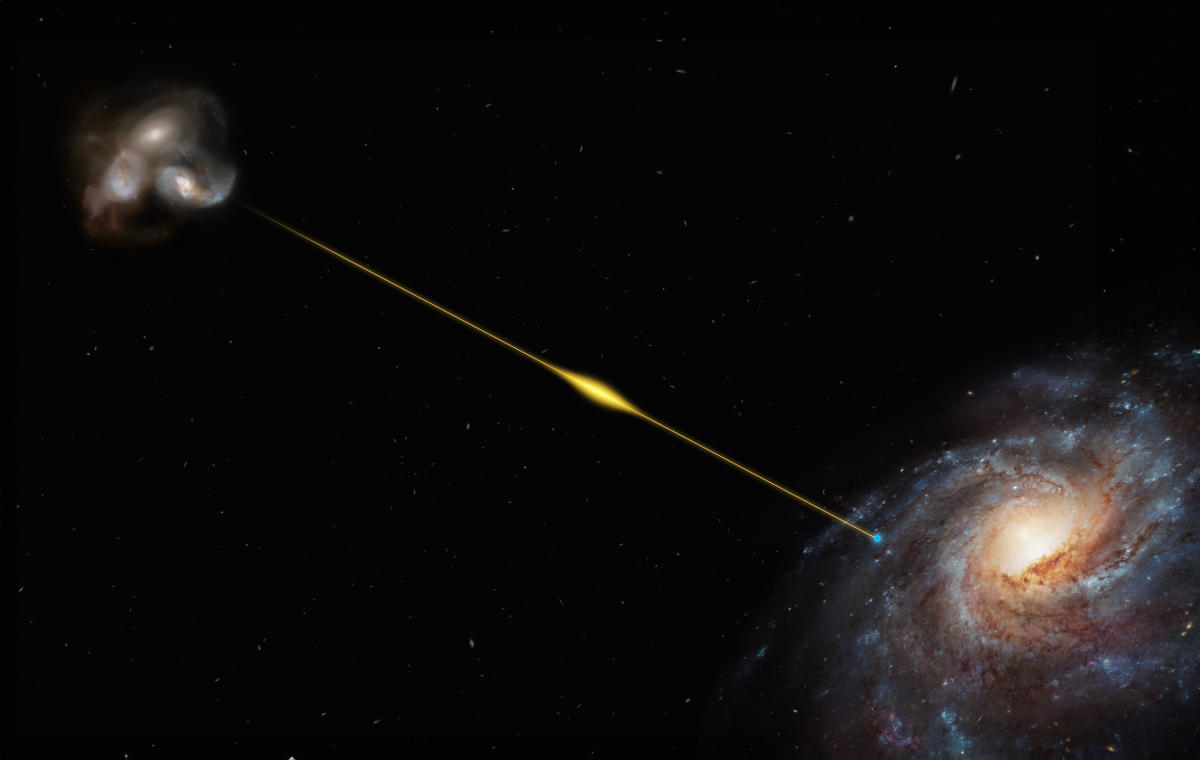An 8 billion-year-old rapid burst of radio waves, originating from ancient colliding galaxies, has astronomers buzzing over its potential to unravel the mystery of the universe’s missing matter. This Fast Radio Burst (FRB) is not only the oldest, but also the most distant FRB ever observed, offering scientists a valuable tool to “weigh” the universe. FRBs, known for their fleeting nature, lasting mere milliseconds, have long puzzled researchers due to their elusive origins. However, this groundbreaking discovery, named FRB 20220610A, could provide some much-needed clarity by originating from a group of merging galaxies.
The momentous FRB was detected by the Australian Square Kilometre Array Pathfinder (ASKAP), a network of radio telescopes located in Western Australia. Despite its fleeting nature, the burst released an astonishing amount of energy equivalent to that of the Sun over 30 years. Stuart Ryder, the lead researcher from Macquarie University, explained, “Using ASKAP’s array of dishes, we were able to determine precisely where the burst came from. Then we used the European Southern Observatory (ESO) Very Large Telescope (VLT) in Chile to search for the source galaxy, finding it to be older and further away than any other FRB source found to date, and likely within a small group of merging galaxies.”
This discovery reignites the search for the missing matter in the universe. Scientists have long known that almost half of the matter expected to exist in the universe is mysteriously absent. This missing matter, not to be confused with dark matter, is believed to be composed of atoms called baryons, which consist of protons and neutrons. Despite the best efforts of advanced telescopes, this elusive matter has evaded detection for decades. Recent studies have suggested that this matter is sparsely distributed between galaxies, with a density equivalent to just two atoms in an average-sized office room on Earth.
However, scientists have reason to believe that FRBs could be the key to unlocking the location of this enigmatic matter in the cosmos. As these bursts traverse millions or billions of light-years, they interact with the missing matter, causing their radiation to disperse. By studying the distances to a handful of FRBs, scientists could gain insight into the density of the universe and potentially locate the missing baryonic matter. Ryan Shannon, an Associate Professor at Swinburne University of Technology, stated, “Fast radio bursts sense this ionized material. Even in space that is nearly perfectly empty, they can ‘see’ all the electrons, and that allows us to measure how much stuff is between the galaxies.”
This breakthrough discovery confirms the Macquart relation, named after late Australian astronomer Jean-Pierre ‘J-P’ Macquart, which suggests that the further away an FRB is, the more diffuse gas it reveals between galaxies. The researchers behind this study propose that with the current technological advancements, astronomers should be able to detect thousands of FRBs across the sky, even at greater distances.
ASKAP has played a vital role in pinpointing around half of the FRBs sourced thus far, making it the most effective tool at astronomers’ disposal. However, the future looks even brighter with the construction of the Square Kilometre Array (SKA) telescopes, set to become the two largest radio telescopes in the world. These telescopes, once operational in Australia and South America, will enable astronomers to detect more ancient FRBs, surpassing even the record-breaking discovery mentioned above. Additionally, the development of the Extremely Large Telescope (ELT) in Northern Chile will allow researchers to precisely locate the sources of detected FRBs.
Despite not knowing the exact cause of these energetic bursts, this study affirms that FRBs are common cosmic events that could help researchers detect matter between galaxies and further unravel the mysteries of the universe. As Ryan Shannon concluded, “While we still don’t know what causes these massive bursts of energy, the paper confirms that fast radio bursts are common events in the cosmos and that we will be able to use them to detect matter between galaxies and better understand the structure of the universe.”
The team’s ground-breaking research was published in the journal Science on Thursday, October 19.


